Nurture Nature Center Observation Station
The Nurture Nature Center operates several observational tools or sensors that are on display for visitors. Just as a doctor might use many sensors to better understand your health, scientists use sensors to better understand our planet. Where a doctor would use a thermometer to measure your temperature and a stethoscope to hear the rhythms of your heart, an earth scientist might use a weather station to measure our planet’s temperature and a seismograph to measure its vibrations.
Our weather station can measure much more than just temperature. It can measure seven atmospheric properties including humidity, air pressure, wind speed, wind direction, solar radiance, precipitation rates, and air temperature. The screen you see here shows the data from our weather station updated in real time.
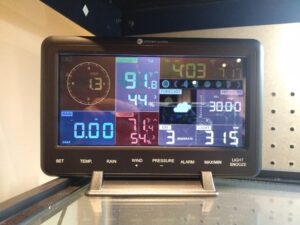 Photo of the weather station display inside NNC’s Science Hall.
Photo of the weather station display inside NNC’s Science Hall.
You can also view this data in the dashboard below or at this link HERE
powered by Ambient Weather
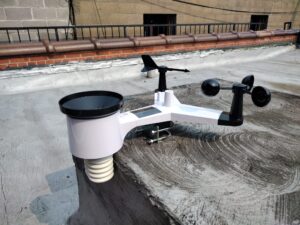 Photo of the weather station on NNC’s roof
Photo of the weather station on NNC’s roof
Meteorologists use this kind of information to make weather forecasts. The National Weather Service uses thousands of weather stations across the country, along with orbiting satellites to help make its weather forecasts.
There are other atmospheric properties that we can measure. Outside of our building we have an air quality monitor that measures the concentration of very small particles in the air that you might associate with smoke. Particle pollution can be a very serious health concern. Sometimes distant wildfires can produce high levels of these small particles that lead to poor air quality. You can see the data from our air quality sensor HERE.
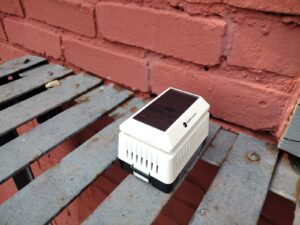 Photo of the air quality monitor at NNC
Photo of the air quality monitor at NNC
Meteorologists use air particle detectors to measure air quality and issue warnings when air quality is poor. Scientists also measure other parts of the atmosphere like the concentration of gases including Nitrogen, Oxygen, and Carbon Dioxide. In addition, scientists measure the abundance of pollen, lead, soot, radiation, and many other factors of the air.
The Earth itself is subject to change and motion. We can detect some of these motions with our seismometer. The seismometer is extremely sensitive to very small vibrations. So sensitive that it must be kept under glass so air currents don’t disrupt its measurements. During volcanic eruptions and earthquakes, vibrations spread out across the surface and move through the Earth. These vibrations travel all the way around the planet and are detectable with this device. The data is used to produce a seismograph which you can see on the screen here. When people are in the building the data is very messy. At night when the building is quiet, we detect earthquakes about once a month with this machine. Usually, the earthquakes are being detected from hundreds or even thousands of miles away.
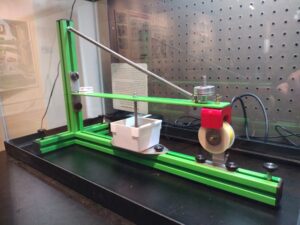 Photo of the seismometer at NNC located in the Science Hall.
Photo of the seismometer at NNC located in the Science Hall.
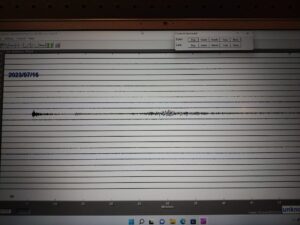 Image of data recorded on the seismometer at NNC. This graph is called a seismograph and it shows the vibrations detected by the monitor.
Image of data recorded on the seismometer at NNC. This graph is called a seismograph and it shows the vibrations detected by the monitor.
Scientists use networks of seismometers to detect earthquakes. With at least three seismometers located in widely spaced different locations scientists can determine the exact time, intensity, and origin point for any earthquake anywhere in the world. This information can also be used to learn about the structure of the interior of the earth. In some cases, it can even be used to warn people of an impending earthquake or volcanic eruption, but at the moment our ability to predict these kinds of events is in its infancy.
What and How We Measure
WEATHER STATION
Our weather station measures humidity with a capacitor in a device called a hygrometer. Capacitors store electric charge like a battery. The capacitor in this case is designed to lose that charge through the air pretty easily. The more water vapor in the air the faster it loses its charge. By measuring the rate that the capacitor loses its charge we can measure the humidity.
To measure air pressure, we use a barometer using another capacitor. The barometer’s capacitor loses charge faster when a small metal plate is pushed closer to it. The metal plate is connected to a diaphragm that moves up when the air pressure is higher and moves down and away when the pressure is lower.
Wind speed is measured using the wind cups. When the wind blows it causes the cups to rotate on a shaft. The shaft has a magnet on it and inside the weather station there is a device called a reed switch. When the magnet moves near the switch it closes and the weather station senses that as one rotation of the shaft. If we count the number of rotations per minute, we can measure wind speed.
Wind direction is measured in a similar way. Another shaft has a magnet that can move near several more reed switches. If the wind is blowing out of the north, then the magnet will be near a particular reed switch and if it blows out of the south then the shaft rotates causing the magnet to be near a different reed switch. Keeping track of which reed switch is on tells us the current wind direction.
The weather station is powered by a small solar panel that serves as a solar radiance detector as well. The electricity from the panel powers the other devices but we can also measure changes in the power coming from the panel to directly measure how sunny or cloudy it is.
Rain is measured with a tip cup counter. When it rains the water runs down the funnel and into a small cup. When the cup is full it tips over and spills out its water. As the cup tips it moves a magnet passed yet another reed switch. By counting the number of times the cup moves, we can count how much rain is falling.
We can measure air temperature with a digital thermometer that senses changes in temperature by measuring changes in the electrical resistance of a device called a thermoresistor. When temperatures go up resistance goes up, when temperatures go down resistance goes down.
AIR QUALITY
The air quality monitor has a chamber open to the outside air. On one side of the chamber there is a small laser light and on the other side there is a laser light detector. When there are more particles in the air more light is scattered away from the detector. The amount of laser light detected gives us a measure of how many particles are in the air.
SEISMOMETER
The seismometer has a large magnet on the end of a lever. The magnet has a lot of mass and there is a stack of iron disks on the end of the lever to increase its mass even more. Like all masses, the mass at the end of the lever has inertia meaning it resists being moved. The mass is isolated from the Earth as much as possible by balancing it on a low friction hinge held up by a vibration absorbing spring. Near the magnet there is a coil of copper wire which is connected to the base of the seismometer and connected firmly to the Earth. When the Earth moves due to an earthquake the copper coil moves with it but the magnet stays still. As the copper coil moves in and out of the magnetic field it causes electricity to flow in the wire. A computer monitors the flow of electricity which we see as data on the seismograph.

